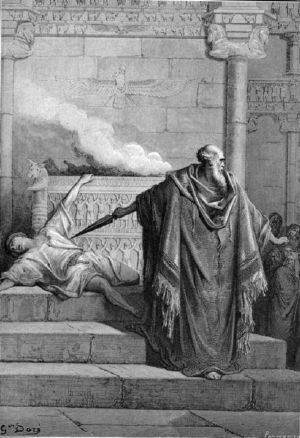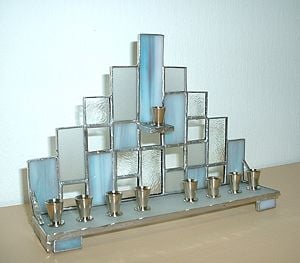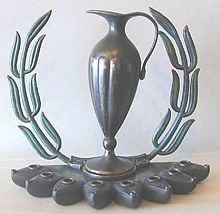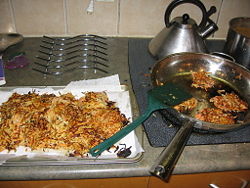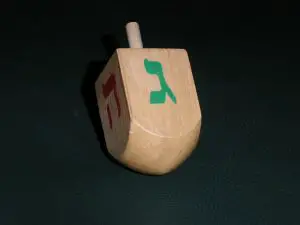Hanukkah
| Hanukkah | |
|---|---|
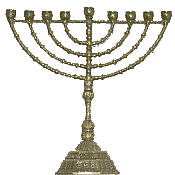
| |
| A simple modern menorah. | |
| Official name | Hebrew: ◊ó÷≤◊†÷Ľ◊õ÷ł÷ľ◊Ē or ◊ó◊†◊ē◊õ◊Ē English translation: "Renewal/Rededication" (of the Temple in Jerusalem) |
| Also called | Festival of Lights, Festival of Dedication |
| Observed by | Jews in Judaism |
| Type | Jewish |
| Significance | One of two rabbinically ordained festivals. The Maccabees successfully rebelled against Antiochus IV Epiphanes. The Temple in Jerusalem was purified, and the wicks of the Menorah miraculously burned for eight days with oil enough for only one day. |
| Begins | 25 Kislev |
| Ends | 2 Tevet or 3 Tevet |
| Celebrations | Lighting candles each night of the festival in a special Hanukkah menorah in a visible location. Playing the dreidel (sevivon) game, eating foods fried in oil, such as latkes and (jelly doughnuts). |
| Related to | Purim, as a rabbinically decreed holiday. |
Hanukkah (Hebrew: ◊ó◊†◊ē◊õ◊Ē), the Jewish Festival of Rededication (also known as the Festival of Lights) is an eight-day Jewish holiday marking the rededication of the Temple of Jerusalem after the Macabeean revolt of the second century B.C.E. It begins on the twenty-fifth day of the Jewish calendar month of Kislev, which can occur in late November, or throughout December, occasionally continuing into the first week of January. The festival is observed in Jewish homes by the kindling of lights on each of the festival's eight nights, one on the first night, two on the second, and so on.
In Hebrew, the word Hanukkah is written ◊ó◊†÷Ľ◊õ◊Ē or ◊ó◊†◊ē◊õ◊Ē. It is most commonly transliterated to English as Chanukah or Hanukkah, the latter because the sound represented by "CH" (as in "loch") does not exist in the modern English language.
The holiday is a joyous one, celebrated with various traditions of food, games, special prayers, and gift-giving. Although not one of the most sacred Jewish holidays, it has grown in importance in recent centuries, especially in secular Jewish homes, where it has become a Jewish alternative to the Christian celebration of Christmas.
In addition to honoring the rededication of the Temple, Hanukkah also commemorates the "miracle of the oil," in which enough holy oil for one day lasted for eight days. Spiritually, it celebrates the triumph of Judaism's spiritual values as embodied in its Torah, symbolized by the light of the Menorah, as well as the victory of the Jews over the armies of the tyrant Antiochus IV.
The story
Around 200 B.C.E. Jews lived as a semi-autonomous people in the land of Israel, referred to at the time as Judea, which was controlled by the Seleucid Greek king of Syria, whose administrative area emerged after the death of Alexander the Great. The Jewish people paid taxes to their Greco-Syrian overlords and accepted the Seleucids' legal authority. However, they were generally free to follow their own faith, maintain their own jobs, and engage in trade.
By 175 B.C.E. Antiochus IV Epiphanes ascended to the Seleucid throne. Known in both Jewish and Greek sources as an arrogant and vainglorious ruler, Antiochus soon became the bane of the Jews. After his choice for the high priesthood in Jerusalem, Menelaus, was forced to abdicate the office, Antiochus came to Jerusalem and plundered the Temple. Certain Jews rebelled violently at this, and Antiochus retaliated with utter ruthlessness.
In 168 B.C.E., his officer, Apollonius, captured Jerusalem and massacred many men, women, and children among the Jews. A royal decree was issued proclaiming the abolition of Jewish worship. Sabbaths and festivals were outlawed; circumcision was banned; sacred scriptures were to be surrendered, and Jews were compelled to offer sacrifices to idols. The possession of a sacred book or the performance of the rite of circumcision was reportedly punished with death. [1]
In 167 B.C.E. Antiochus ordered an altar to Zeus erected in the Temple and commanded the Jews to offer sacrifices to it, an intolerable outrage to pious Jews.[2] Mattathias, a Jewish priest, led a violent rebellion against Antiochus' tyranny. His son Judah became known as Judah Maccabee ("Judah the Hammer"). By 166 B.C.E. Mattathias had died, and Judah took his place as leader. Under his generalship, the Jewish revolt against the Seleucid monarchy was successful. Jerusalem was liberated in 165 B.C.E., and the defiled Temple was reclaimed. [3]
Judah then ordered the Temple to be cleansed, a new altar to be built in place of the polluted one, and new holy vessels to be made. According to the Talmud, oil was needed for the sacred menorah in the Temple, which was supposed to burn throughout the night every night. But there was only enough oil to burn for one day, yet miraculously, it burned for eight days, the time needed to prepare a fresh supply of oil for the menorah. An eight-day festival was declared to commemorate this miracle.
While the part of the story concerning the oil is disputed, it is the traditionally accepted view. The apocryphal books known as 1 Maccabees and 2 Maccabees record other versions of the origin of the eight days of Hanukkah. Neither of them mentions the miracle of the oil. 1 Maccabees reads that, "For eight days they celebrated the rededication of the altar. Then Judah and his brothers and the entire congregation of Israel decreed that the days of the rededication… should be observed… every year… for eight days. (1 Mac.4:56-59)" 2 Maccabees says simply: "The Jews celebrated joyfully for eight days, as on the feast of Booths (Sukkot)."
Historical sources
In the Talmud
The miracle of Hanukkah is described in the Talmud. The Gemara, in tractate Shabbat 21b, [4] says that after the occupiers had been driven from the Temple, the Maccabees discovered that almost all of the ritual olive oil had been profaned. They found only a single container that was still sealed by the High Priest, with enough oil to keep the Menorah in the Temple lit for a single day. They used this, and miraculously, that oil burned for eight days (the time it took to have new oil pressed and made ready).
The Talmud presents three customs in lighting the Menorah:
- Lighting one light each night,
- One light each night for each member of the household, or,
- Changing the number of candles each night.
As is often the case in the Talmud, the rabbis disagreed on the best option, and there was a serious dispute over how the last option was to be performed: either by displaying eight lamps on the first night of the festival, and reduce the number on each successive night; or by beginning with one lamp the first night, increasing the number till the eighth night. The followers of Shammai favored the former custom; the followers of Hillel advocated the latter. Jews today generally follow Hillel's practice rather than Shammai's on this and most other issues.
The Septuagint and other sources
The Books of Maccabees are not part of the Hebrew Bible, but are part of deuterocanonical historical and religious material preserved in the Septuagint, or Greek version of the Hebrew scriptures. Beside the already mentioned stories in 1 Maccabees and 2 Maccabees, an older story is also alluded to in 2 Maccabees 1:18 et seq. Here, the relighting of the altar-fire by Nehemiah after the Jews returned from Babylon was due to a miracle which occurred on the twenty-fifth of Kislev. It appears that this is the origin of the traditional date of the rededication of the altar by Judah Maccabee.
Another source related to Hanukkah is the Megillat Antiokhos. The rabbinical sage Saadia Gaon, who translated this scroll into Arabic in the ninth century C.E., ascribed it to the Maccabees themselves, but this seems unlikely, since internal evidence shows that its authors were aware of the destruction of the Temple in 70 C.E. Recent scholarship dates it to somewhere between the second and fifth centuries.[5]
Hanukkah is also mentioned in the Christian Bible in the book of Gospel of John 10:22-25. Here, Jesus visits the Temple during Hanukkah, and his fellow Jews ask him "If you are the Messiah, tell us plainly." Jesus answers, "I did tell you, but you do not believe."
Hanukkah rituals
Hanukkah has relatively simple religious rituals that are performed during the eight nights and days of the holiday. Some aspects are practiced at home by the family, other aspects are communal. There are additions to the regular daily prayer services in the Siddur, the Jewish prayer book. Jewish law does not require one to refrain from activities on Hanukkah that would fit the Jewish definition of "work." [6] Thus people are allowed to go to school and work. Employees are not given the holiday off and children are generally only given two or three days off from school.
Kindling the Hanukkah Lights
The primary ritual, according to Jewish law and custom, is to light a single light each night for eight nights. An extra light called a shamash, meaning guard or servant is also lit each night, and is given a distinct location, usually higher or lower than the others. The purpose of the extra light is to adhere to the prohibition, specified in the Talmud (Tracate Shabbat 21b-23a), against using the Hanukkah lights for anything other than publicizing and meditating on the Hanukkah story. This differs from Sabbath candles which are meant to be used for illumination.
The Hanukkah lights may be either candles or oil lamps. Electric lights are sometimes used and are acceptable in places where open flame is not permitted, such as a hospital room. Most Jewish homes have a special candelabra or oil lamp holder for Hanukkah, which holds eight lights plus the additional shamash light. By contrast, the Temple menorah, described in Exodus 25:31, had six branches plus a central shaft, for a total of seven lamps.
Hanukkah lights are not for the "lighting of the house within," but rather for the "illumination of the house without," so that passers-by should see it and be reminded of the holiday's miracle. Accordingly, lamps are traditionally set up at a prominent window or near the door leading to the street. However, most Hasidic groups light lamps near an inside doorway, not necessarily in public view. According to this tradition, the lamps are placed on the opposite side from the mezuzah, so that when one passes through the door he is surrounded by the holiness of mitzvoth. It is customary among some Ashkenazim to have a separate menorah for each family member.
Blessings over the candles
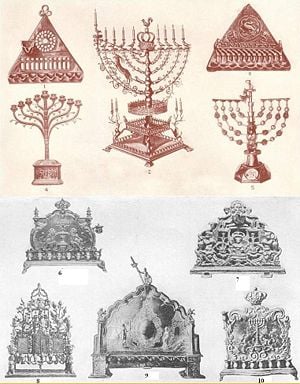
Typically three blessings (Brachot, singular Brachah) are recited during this eight-day festival. On the first night of Hanukkah, Jews recite all three blessings; on all subsequent nights, they recite only the first two. The blessings are said before or after the candles are lit, depending on tradition. On the first night of Hanukkah one light is lit on the right side of the Menorah, on the following night a second light is placed to the left of the first and is lit first proceeding from left to right, and so on each night.
The first blessing
Recited all eight nights just prior to lighting the candles:
Baruch atah Adonai, Eloheinu melech ha-olam, asher kid'shanu b'mitzvotav v'tzivanu l'hadlik neir (shel) chanukah.
- Translation: "Praised are You, Lord our God, King of the Universe, Who sanctified us with His commandments and commanded us to kindle the Hanukkah lights."
The second blessing
Recited all eight nights just prior to lighting the candles:
Baruch atah Adonai, Eloheinu melech ha-olam, she-asah nisim la-avoteinu, bayamim haheim, (u)baz'man hazeh.
- Translation: "Praised are You, Lord our God, King of the universe, Who performed wondrous deeds for our ancestors, in those days, at this season."
The third blessing
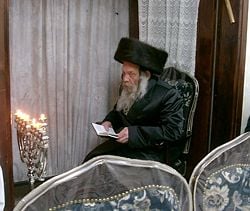
Recited only on the first night just prior to lighting the candles:
Baruch atah Adonai, Eloheinu melech ha-olam, shehecheyanu, v'kiyemanu, vehigi-anu laz'man hazeh.
- Translation: "Praised are You, Lord our God, King of the universe, Who has kept us in life, sustained us, and enabled us to reach this season."
After kindling the lights - Hanerot Halalu
When the lights are kindled the Hanerot Halalu prayer is subsequently recited: (Ashkenazic version):
Hanneirot hallalu anachnu madlikin 'al hannissim ve'al hanniflaot 'al hatteshu'ot ve'al hammilchamot she'asita laavoteinu bayyamim haheim, (u)bazzeman hazeh 'al yedei kohanekha hakkedoshim. Vekhol-shemonat yemei Hanukkah hanneirot hallalu kodesh heim, ve-ein lanu reshut lehishtammesh baheim ella lir'otam bilvad kedei lehodot ul'halleil leshimcha haggadol 'al nissekha ve'al nifleotekha ve'al yeshu'otekha.
- Translation: "We light these lights for the miracles and the wonders, for the redemption and the battles that you made for our forefathers, in those days at this season, through your holy priests. During all eight days of Hanukkah these lights are sacred, and we are not permitted to make them serve except for to look at them in order to express thanks and praise to Your great Name for your miracles, Your wonders and Your salvations."
Singing of Maoz Tzur
Each night after the lighting of the candles, while remaining within eye shot of the candles, Ashkenazim then usually sing the hymn Maoz Tzur, written in Medieval Ashkenaz (Germany). It lists a number of events of persecution in Jewish history, and praises God for survival despite these tragedies.
Other Customs
Various Hassidic and Sefardic traditions have additional prayers that are recited both before and after lighting the Hanukkah lights. This includes the recitation of many Psalms, most notably Psalms 30, 67, and 91 (many Hassidim recite Psalm 91 seven times after lighting the lamps, as was taught by the Baal Shem Tov), as well as other prayers and hymns, each congregation according to its own custom.
Additions to the daily prayers
An addition is made to the "hoda'ah" (thanksgiving) benediction in the Amidah, called Al ha-Nissim ("On the Miracles"). This addition refers to the victory achieved over the Syrians by the Hasmonean Mattathias and his sons. The same prayer is added to the grace after meals. In addition, the Hallel Psalms are sung during each morning service and the Tachanun penitential prayers are omitted. The Torah is read every day in the synagogue, the first day beginning from Numbers 6:22 (According to some customs, Numbers 7:1), and the last day ending with Numbers 8:4.
Since Hanukkah lasts eight days, it includes at least one, and sometimes two, Sabbaths. The weekly Torah portion for the first Sabbath is almost always Miketz, telling of Joseph's dream and his enslavement in Egypt. The Haftarah reading for the first Sabbath Hanukkah is Zechariah 2:14-4:7. When there is a second Sabbath on Hanukkah, the Haftarah reading is from I Kings 7:40-50.
The Hanukkah menorah is also kindled daily in the synagogue, at night with the blessings and in the morning without the blessings. The menorah is not lit on the Sabbath, but rather prior to the beginning of the Sabbath at night and not at all during the day.
Zos Hanukkah
The last day of Hanukkah is known as Zos Hanukkah, from the verse in the Book of Numbers 7:84 "Zos Chanukas Hamizbe'ach"‚ÄĒ"This was the dedication of the altar," which is read on this day in the synagogue. According to the teachings of the Kaballah and Hasidism, this day is the final "seal" of the High Holiday season of Yom Kippur, and is considered a time to repent out of love for God. In this spirit, many Hassidic Jews wish each other "Gmar chasimah tovah," "may you be sealed totally for good," a traditional greeting for the Yom Kippur season. It is taught in Hassidic and Kabbalistic literature that this day is particularly auspicious for the fulfillment of prayers.
Traditional Hanukkah foods
Potato pancakes, known as latkes in Yiddish, are traditionally associated with Hanukkah (especially among Ashkenazi families) because there is a custom to eat foods fried or baked in oil. This commemorates the fact that the original miracle of the Hanukkah menorah involved the discovery of the small flask of oil sealed by the Jewish High Priest in the Temple of Jerusalem. Many Sephardic families, as well as Polish Ashkenazim and Israelis, have the custom to eat all kinds of doughnuts (Yiddish: ◊§◊ź◊†◊ė◊©◊ß◊Ę◊° pontshkes), (bimuelos, or sufganiyot) which are deep-fried in oil.
Hanukkah games
Dreidel
The dreidel, or sevivon in Hebrew, (a four-sided spinning top) is associated with Hanukkah. It has four sides, each engraved with a different Hebrew letter:
- נ (Nun)
- ג (Gimel)
- ◊Ē (Hey)
- ש (Shin)
These letters are an acronym for the Hebrew words, ◊†◊° ◊í◊ď◊ē◊ú ◊Ē◊ô◊Ē ◊©◊Ě, Nes Gadol Haya Sham‚ÄĒ"A great miracle happened there" (referring to the miracle of the oil that took place in the Temple in Jerusalem).
In the State of Israel, the fourth side of most dreidels instead shows the letter ◊§ (Pe), rendering the acronym, ◊†◊° ◊í◊ď◊ē◊ú ◊Ē◊ô◊Ē ◊§◊Ē, Nes Gadol Haya Po‚ÄĒ"A great miracle happened here" (referring to the fact that the miracle occurred in the land of Israel). This custom was adopted after the capture of East Jerusalem during the Six Day War.
Traditional Jewish commentaries ascribe deep symbolism to the markings on the dreidel. One commentary, for example, connects the four letters with the four exiles to which the nation of Israel was historically subject‚ÄĒBabylonia, Persia, Greece, and Rome.
The dreidel is the centerpiece of a game which is often played after the lighting of the Hanukkah menorah, to keep the children interested during the short time the candles are burning. Each player starts out with 10 or 15 coins, nuts or other markers, and places one marker into the "pot." The first player spins the dreidel, which lands with one of its symbols facing up, indicating the appropriate action to be taken, corresponding to one of the following Yiddish words:
- Nun - nisht - "not" - nothing happens and the next player spins
- Gimel - gants - "all" - the player takes the entire pot
- Hey - halb - "half" - the player takes half of the pot, rounding up if there is an odd number
- Shin - shtel ayn - "put in" - the player puts one marker in the pot
The game may last until one person has won everything.
The dreidel game is played in part to commemorate a game that the Jews under Greek domination played to camouflage their Torah study. Though the Greeks made a law forbidding the study of Torah, the Jews would gather in caves to engage in learning. A lookout was posted to alert the group to the presence of Greek soldiers; if he spotted them, he would give a signal and the Jews would hide their scrolls and begin playing with spinning tops (dreidels) and coins. This ruse gave the impression that they were engaged in gambling, not learning.
Hanukkah gelt
Hanukkah gelt (Yiddish for "money") is often distributed to children to enhance their enjoyment of the holiday. The amount is usually in small coins, although grandparents or other relatives may give larger sums as an official Hanukkah gift. In Israel, Hanukkah gelt is known as dmei Hanukkah. Many Hassidic Rebbes distribute coins to those who visit them during Hanukkah. Hassidic Jews consider this to be an auspicious blessing from the Rebbe, and a segulah for success.
Twentieth-century American chocolatiers picked up on the gift/coin concept by creating chocolate gelt, or sweetened chocolate shaped and stamped like coins and wrapped in gold or silver foil. Chocolate gelt is often used in place of money in dreidel games.
Interaction with other traditions
Hanukkah gained increased importance with many Jewish families in the twentieth century, including large numbers of secular Jews who wanted a Jewish alternative to the Christmas celebrations that often overlap with Hanukkah.
In recent years, an amalgam of Christmas and Hanukkah has emerged ‚ÄĒ dubbed "Chrismukkah" ‚ÄĒ celebrated by some mixed-faith families, particularly in the United States. A decorated tree has come to be called a "Hanukkah bush." Though it was traditional to give "gelt" or money coins to children during Hanukkah, in many families this has changed into gifts in order to prevent Jewish children from feeling left out of the Christmas gift giving.
These secular traditions are not a traditional part of the Hanukkah observance, and are often frowned upon by more observant and traditional-minded Jews.
Background
Chronology
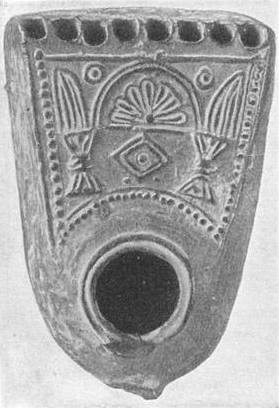
- 198 B.C.E.: Armies of the Selucid King Antiochus III (Antiochus the Great) oust Ptolemy V from Judea and Samaria.
- 175 B.C.E.: Antiochus IV (Epiphanes) ascends the Seleucid throne.
- 168 B.C.E.: Under the reign of Antiochus IV, the Temple is looted, Jews are massacred, and Judaism is outlawed.
- 167 B.C.E.: Antiochus orders an altar to Zeus erected in the Temple. Mattathias, and his five sons John, Simon, Eleazar, Jonathan, and Judah lead a rebellion against Antiochus. Judah becomes known as Judah Maccabe (Judah The Hammer).
- 166 B.C.E.: Mattathias dies, and Judah takes his place as leader. The Hasmonean Jewish Kingdom begins; It lasts until 63 B.C.E.
- 165 B.C.E.: The Jewish revolt against the Seleucid monarchy is successful. The Temple is liberated and rededicated (Hanukkah).
- 142 B.C.E.: Establishment of the Second Jewish Commonwealth. The Seleucids recognize Jewish autonomy. The Seleucid kings have a formal overlordship, which the Hasmoneans acknowledged. This inaugurates a period of great geographical expansion, population growth, and religious, cultural and social development.
- 139 B.C.E.: The Roman Senate recognizes Jewish autonomy.
- 131 B.C.E.: Antiochus VII besieges Jerusalem, but withdraws.
- 130 B.C.E.: Antiochus VII dies. The Hasmonean Jewish Kingdom throws off Syrian rule completely
- 96 B.C.E.: An eight year civil war begins.
- 83 B.C.E.: Consolidation of the Kingdom in territory east of the Jordan River.
- 63 B.C.E.: The Hasmonean Jewish Kingdom comes to an end due to rivalry between the brothers Aristobulus II and Hyrcanus II, both of whom appeal to the Roman Republic to intervene and settle the power struggle on their behalf. The Roman general Gnaeus Pompeius Magnus (Pompey the Great) is dispatched to the area. Twelve thousand Jews are massacred as Romans enter Jerusalem. The Priests of the Temple are struck down at the Altar. Rome annexes Judea.
When Hanukkah occurs
The dates of Hanukkah are determined by the Hebrew Calendar. Hanukkah begins at the twenty-fifth day of Kislev and concludes on the second or third day of Tevet (Kislev can have 29 or 30 days). The Jewish day begins at sunset, whereas the Gregorian Calendar begins the day at midnight. So, the first day of Hanukkah actually begins at sunset of the day immediately before the date noted on Gregorian calendars.
Hanukkah's dates in the Gregorian calendar
Hanukkah begins at sundown on the evening before the date shown.
|
|
|
|
See also
- Hasmonean
- Maccabees
- Jewish holidays
- Temple in Jerusalem
Notes
- ‚ÜĎ Antiochus IV. www.jewishencyclopedia.com. Retrieved August 1, 2007.
- ‚ÜĎ Many scholars believe this to be the "abomination of desolation" referred to in Daniel 11: 31 and 12:11
- ‚ÜĎ 1 Macc. iv. 59.Retrieved December 13, 2007.
- ‚ÜĎ The Babylonian Talmud, tractate Shabbat 21b. The discussion focuses on Shabbat candles and moves to Hanukkah candles. Retrieved December 13, 2007.
- ‚ÜĎ Benjamin Zvieli. "The Scroll of Antiochus" [1] accessdate 2007-01-28.
- ‚ÜĎ Shulkhan Arukh Orach Chayim 670:1
ReferencesISBN links support NWE through referral fees
- Carlon, David D. Macabee. Parker, CO: Outskirts Press, 2007. ISBN 9781432701659
- Healy, Mark and Hook, Richard. Warriors of the Old Testament: Joshua, King David, Nebuchadnezzar, Judas Maccabeus. Firebird Books, Penguin imprint, 1990. ISBN 9781853141027
- Wolfe, Robert. The Origins of the Messianic Ideal. J-Rep, 2003. ISBN 9780964246539
- Wolfson, Ron and Grishaver, Joel Lurie. Hanukkah, 2nd Edition: The Family Guide to Spiritual Celebration, 2nd edition, Vermont: Jewish Lights Publishing; 2001. ISBN 9781580231220
External links
All links retrieved June 25, 2024.
- Complete Hanukkah Guide www.chabad.org.
- Chanukah - A Spiritual Holiday. www.torah.org.
- Sephardic traditions and history. www.midrash.org.
Credits
New World Encyclopedia writers and editors rewrote and completed the Wikipedia article in accordance with New World Encyclopedia standards. This article abides by terms of the Creative Commons CC-by-sa 3.0 License (CC-by-sa), which may be used and disseminated with proper attribution. Credit is due under the terms of this license that can reference both the New World Encyclopedia contributors and the selfless volunteer contributors of the Wikimedia Foundation. To cite this article click here for a list of acceptable citing formats.The history of earlier contributions by wikipedians is accessible to researchers here:
The history of this article since it was imported to New World Encyclopedia:
Note: Some restrictions may apply to use of individual images which are separately licensed.

